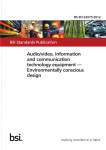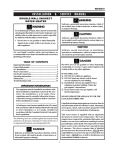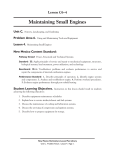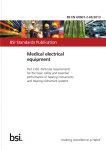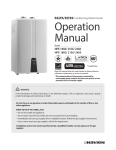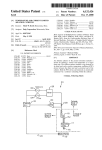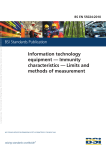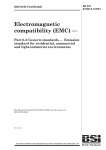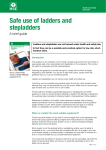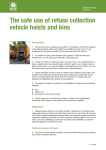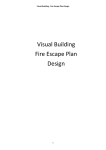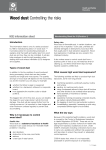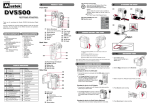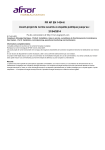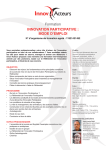Download EN 61010-2-010
Transcript
BS EN 61010-2-010:2014 BSI Standards Publication Safety requirements for electrical equipment for measurement, control and laboratory use Part 2-010: Particular requirements for laboratory equipment for the heating of Materials BRITISH STANDARD BS EN 61010-2-010:2014 National foreword This British Standard is the UK implementation of EN 61010-2-010:2014. It is identical to IEC 61010-2-010:2014. It supersedes BS EN 61010-2-010:2003 which is withdrawn. The UK participation in its preparation was entrusted to Technical Committee EPL/66, Safety of measuring, control and laboratory equipment. A list of organizations represented on this committee can be obtained on request to its secretary. This publication does not purport to include all the necessary provisions of a contract. Users are responsible for its correct application. © The British Standards Institution 2014. Published by BSI Standards Limited 2014 ISBN 978 0 580 79878 8 ICS 19.080; 71.040.20 Compliance with a British Standard cannot confer immunity from legal obligations. This British Standard was published under the authority of the Standards Policy and Strategy Committee on 30 November 2014. Amendments/corrigenda issued since publication Date Text affected BS EN 61010-2-010:2014 EUROPEAN STANDARD EN 61010-2-010 NORME EUROPÉENNE EUROPÄISCHE NORM November 2014 ICS 19.080; 71.040.20 Supersedes EN 61010-2-010:2003 English Version Safety requirements for electrical equipment for measurement, control and laboratory use - Part 2-010: Particular requirements for laboratory equipment for the heating of Materials (IEC 61010-2-010:2014) Règles de sécurité pour appareils électriques de mesurage, de régulation et de laboratoire - Partie 2-010: Exigences particulières pour appareils de laboratoire utilisés pour l'échauffement des matières (CEI 61010-2-010:2014) Sicherheitsbestimmungen für elektrische Mess-, Steuer-, Regel- und Laborgeräte - Teil 2-010: Besondere Anforderungen an Laborgeräte für das Erhitzen von Stoffen (IEC 61010-2-010:2014) This European Standard was approved by CENELEC on 2014-10-30. CENELEC members are bound to comply with the CEN/CENELEC Internal Regulations which stipulate the conditions for giving this European Standard the status of a national standard without any alteration. Up-to-date lists and bibliographical references concerning such national standards may be obtained on application to the CEN-CENELEC Management Centre or to any CENELEC member. This European Standard exists in three official versions (English, French, German). A version in any other language made by translation under the responsibility of a CENELEC member into its own language and notified to the CEN-CENELEC Management Centre has the same status as the official versions. CENELEC members are the national electrotechnical committees of Austria, Belgium, Bulgaria, Croatia, Cyprus, the Czech Republic, Denmark, Estonia, Finland, Former Yugoslav Republic of Macedonia, France, Germany, Greece, Hungary, Iceland, Ireland, Italy, Latvia, Lithuania, Luxembourg, Malta, the Netherlands, Norway, Poland, Portugal, Romania, Slovakia, Slovenia, Spain, Sweden, Switzerland, Turkey and the United Kingdom. European Committee for Electrotechnical Standardization Comité Européen de Normalisation Electrotechnique Europäisches Komitee für Elektrotechnische Normung CEN-CENELEC Management Centre: Avenue Marnix 17, B-1000 Brussels © 2014 CENELEC All rights of exploitation in any form and by any means reserved worldwide for CENELEC Members. Ref. No. EN 61010-2-010:2014 E BS EN 61010-2-010:2014 EN 61010-2-010:2014 -2- Foreword The text of document 66/532/FDIS, future edition 3 of IEC 61010-2-010, prepared by IEC/TC 66 "Safety of measuring, control and laboratory equipment" was submitted to the IEC-CENELEC parallel vote and approved by CENELEC as EN 61010-2-010:2014. The following dates are fixed: • latest date by which the document has to be implemented at national level by publication of an identical national standard or by endorsement (dop) 2015-07-30 • latest date by which the national standards conflicting with the document have to be withdrawn (dow) 2017-10-30 This document supersedes EN 61010-2-010:2003. Attention is drawn to the possibility that some of the elements of this document may be the subject of patent rights. CENELEC [and/or CEN] shall not be held responsible for identifying any or all such patent rights. This standard covers the Principle Elements of the Safety Objectives for Electrical Equipment Designed for Use within Certain Voltage Limits (LVD - 2006/95/EC). Endorsement notice The text of the International Standard IEC 61010-2-010:2014 was approved by CENELEC as a European Standard without any modification. BS EN 61010-2-010:2014 EN 61010-2-010:2014 -3- Annex ZA (normative) Normative references to international publications with their corresponding European publications The following documents, in whole or in part, are normatively referenced in this document and are indispensable for its application. For dated references, only the edition cited applies. For undated references, the latest edition of the referenced document (including any amendments) applies. NOTE 1 When an International Publication has been modified by common modifications, indicated by (mod), the relevant EN/HD applies. NOTE 2 Up-to-date information on the latest versions of the European Standards listed in this annex is available here: www.cenelec.eu Publication Year Title EN/HD Year Annex ZA of EN 61010-1:2010 is applicable except as follows: Addition: ISO 7010 2011 Graphical symbols - Safety colours and safety signs - Registered safety signs EN ISO 7010 2012 –2– BS EN 61010-2-010:2014 IEC 61010-2-010:2014 © IEC 2014 CONTENTS 1 Scope and object ............................................................................................................. 6 2 Normative references ...................................................................................................... 6 3 Terms and definitions ...................................................................................................... 6 4 Tests ............................................................................................................................... 7 5 Marking and documentation ............................................................................................. 7 6 Protection against electric shock ................................................................................... 10 7 Protection against mechanical HAZARDS ......................................................................... 12 8 Resistance to mechanical stresses ................................................................................ 12 9 Protection against the spread of fire .............................................................................. 13 10 Equipment temperature limits and resistance to heat ..................................................... 13 11 Protection against HAZARDS from fluids .......................................................................... 15 12 Protection against radiation, including laser sources, and against sonic and ultrasonic pressure ........................................................................................................ 15 13 Protection against liberated gases and substances, explosion and implosion ................ 15 14 Components and subassemblies ................................................................................... 16 15 Protection by interlocks ................................................................................................. 17 16 H AZARDS resulting from application ................................................................................ 17 17 R ISK Assessment ........................................................................................................... 17 Annexes ............................................................................................................................... 17 Bibliography .......................................................................................................................... 18 Table 1 – Symbols .................................................................................................................. 7 Table 101 – Time-temperature conditions ............................................................................. 15 –6– BS EN 61010-2-010:2014 IEC 61010-2-010:2014 © IEC 2014 SAFETY REQUIREMENTS FOR ELECTRICAL EQUIPMENT FOR MEASUREMENT, CONTROL AND LABORATORY USE – Part 2-010: Particular requirements for laboratory equipment for the heating of materials 1 Scope and object This clause of Part 1 is applicable except as follows: 1.1.1 Equipment included in scope Replacement: This part of IEC 61010 specifies safety requirements for electrically powered laboratory equipment for the heating of materials, where the heating of materials is one of the functions of the equipment. NOTE If all or part of the equipment falls within the scope of one or more other part 2 standards of IEC 61010 as well as within the scope of this standard, it will also need to meet the requirements of those other part 2 standards. In particular, if equipmen is intended to be used for IVD purposes, it will need to meet the requirements of IEC 61010-2-101. 1.1.2 Equipment excluded from scope Addition after item j): aa) equipment for the heating and ventilation of laboratories; bb) sterilizing equipment; cc) heating and/or cooling equipment which the OPERATOR is intended to enter, and which is large enough for the OPERATOR to remain inside with the door or doors closed. 2 Normative references This clause of Part 1 is applicable, except as follows: Addition: ISO 7010:2011, Graphical symbols — Safety colours and safety signs — Registered safety signs 3 Terms and definitions This clause of Part 1 is applicable except as follows: 3.2 Parts and accessories Addition: 3.2.101 HEAT TRANSFER MEDIUM medium used to transfer heat to the material being processed BS EN 61010-2-010:2014 IEC 61010-2-010:2014 © IEC 2014 4 –7– Tests This clause of Part 1 is applicable except as follows: 4.4.2.11 Heating devices Addition: If a HAZARD could be caused by overfilling or under-filling with a liquid HEAT TRANSFER MEDIUM, the equipment shall be tested when empty, partially filled, or overfilled, whichever is least favourable. In case of doubt, the test shall be carried out in more than one condition. The HEAT TRANSFER MEDIUM used for the test shall be of a type specified for NORMAL USE . 5 Marking and documentation This clause of Part 1 is applicable except as follows: 5.1 Marking Table 1 – Symbols Addition: Number Background colour – yellow (optional, not green); symbol and outline – black (optional). 101 5.1.3 Symbol Publication ISO 7010 – W021 Description Warning; Flammable material M AINS supply Addition to item c): If, for periods of 1 min or less after switching on, the actual power or current can be much higher than the marked maximum RATED power or current, the short-term maximum may be marked in brackets after the maximum RATED power or current. 5.1.6 Switches and circuit-breakers Addition: For ovens and similar equipment, there shall be an indication of the “ON” condition on each side of the equipment which has a door in it or has any other opening intended for loading material. 5.2 Warning markings Replacement of the first paragraph by the following: Warning markings specified in 5.1.5.2 c), 5.2.101, 6.1.2 b), 6.1.2.101 2), 7.3.2 b) 3), 7.4, 10.1, 9.5 c), and 13.2.2 shall meet the following requirements: Additional subclause: –8– 5.2.101 BS EN 61010-2-010:2014 IEC 61010-2-010:2014 © IEC 2014 Equipment with high ACCESSIBLE current If the ACCESSIBLE current of the equipment exceeds the limit of 6.3.1 b) or 6.3.2 b) for nonpermanently connected equipment, but is within the limit for PERMANENTLY CONNECTED EQUIPMENT , there shall be a warning marking requiring permanent connection to the supply source. The marking shall be on or beside the cover of the TERMINALS for connection to the supply source, and the warning shall be repeated in the installation instructions. Symbol 14 of Table 1 is an adequate warning marking, particularly when it may not be known in which country the equipment will be used and, therefore, in which language it would be appropriate to print the warning marking. Conformity is checked by inspection. 5.4.3 Equipment installation Replacement: The documentation shall include installation and specific commissioning instructions (examples are listed below) and, if necessary for safety, warnings against HAZARDS which could arise during installation or commissioning of the equipment: a) assembly, location and mounting requirements. If a HAZARD could be caused by hot items falling from the equipment, for example when a door is opened, there shall be a warning that the equipment shall not be mounted on a surface of flammable material; b) instructions for protective earthing; c) connections to the supply, including the warning and statement which are necessary when permanent connection to the supply source is essential (see 5.2.101), and for equipment in which HAZARDOUS LIVE parts may need to be ACCESSIBLE (see 6.1.2), a statement requiring the fitting of a residual current-operated circuit-breaker; d) for PERMANENTLY CONNECTED EQUIPMENT : 1) supply wiring requirements; 2) requirements for any external switch or circuit-breaker (see 6.11.2.1) and external overcurrent protection devices (see 9.6.2), and a recommendation that the switch or circuit-breaker be near the equipment; e) ventilation requirements; f) requirements for special services, for example, air, cooling liquid; g) the maximum sound level produced by equipment which emits sound, if measurement is required by 12.5.1; h) instructions relating to sound level (see 12.5.1); i) any requirement for drying-out (see 5.4.3.101); j) if the heating of materials could lead to liberation of hazardous substances, installation instructions shall warn of any need for an extraction system, additional temperaturelimiting devices relating to safe temperatures for the materials, etc. (also see the note to 5.4.1). NOTE An extraction system is a system which removes air from the building, not a recirculating system. Conformity is checked by inspection. Additional subclause: 5.4.3.101 Drying-out If, after transport or storage in humid conditions, equipment could fail to meet all the safety requirements of this standard, the installation instructions shall specify a period of operation BS EN 61010-2-010:2014 IEC 61010-2-010:2014 © IEC 2014 –9– to dry out the equipment and restore it to NORMAL CONDITION . The instructions shall include a warning that the equipment cannot be assumed to meet all the safety requirements of this standard during the drying-out process. Conformity is checked by inspection. 5.4.4 Equipment operation Addition at the end of item g): (see 5.4.4.101) Addition after item j): aa) specification of additional protection needed by the OPERATOR when HAZARDOUS LIVE parts are permitted to be ACCESSIBLE (see 6.1.2.101); bb) a warning about any possible HAZARDS of explosion, implosion, or the release of toxic or flammable gases arising from the materials being heated (also see 5.4.4 h); cc) specification of HEAT TRANSFER MEDIA which are suitable for use, for example liquids for use in a heating bath. dd) specific requirements for ventilation. Additional subclause: 5.4.4.101 Cleaning and decontamination The instructions shall include recommendations for cleaning and, where necessary, decontamination, together with the recognized generic names of recommended materials for cleaning and decontamination, and an indication of any materials which could be likely to be used but which are incompatible with parts of the equipment or with material contained in it. The instructions shall also state that the RESPONSIBLE BODY shall ensure that: a) appropriate decontamination is carried out if hazardous material is spilled onto or into the equipment; b) no decontamination or cleaning agents are used which could cause a HAZARD as a result of a reaction with parts of the equipment or with material contained in it; c) the manufacturer or his agent is consulted if there is any doubt about the compatibility of decontamination or cleaning agents with parts of the equipment or with material contained in it. Manufacturers should be aware of the internationally recognized “Laboratory Biosafety Manual”, published by the World Health Organization in Geneva, which gives information on decontaminants, their use, dilutions, properties and potential applications. There are also national guidelines which cover these areas. Cleaning and decontamination may be necessary as a safeguard when laboratory heating equipment and any accessories are maintained, repaired, or transferred. Manufacturers should provide a format for the RESPONSIBLE BODY to certify that such treatment has been carried out. Conformity is checked by inspection. 5.4.5 Equipment maintenance and service Addition: – 10 – BS EN 61010-2-010:2014 IEC 61010-2-010:2014 © IEC 2014 If high-temperature or other special cable is used for the MAINS supply cord, the instructions shall state that it is to be replaced only by an equivalent cable. If practicable, instructions shall specify methods for the RESPONSIBLE BODY to check the effective operation of devices or systems for over-temperature protection or liquid-level protection which are necessary for safety, and shall state how often the checks need to be made. 6 Protection against electric shock This clause of Part 1 is applicable except as follows: 6.1 General 6.1.1 Addition after the conformity statement: If a drying-out process is specified (see 6.7.2.2.101), this is carried out in accordance with the operator manual (see 5.4.3.101) before making the measurements of 6.3. Drying-out is followed by a rest period of 2h, with the equipment de-energized, before the measurements are taken. Measurements are made with the equipment at ambient temperature. If there is doubt whether the permissible limits could be exceeded at maximum operating temperature, the relevant measurements are repeated at maximum operating temperature and the higher values are used. Additional subclause: 6.1.2.101 Exceptions for ovens and furnaces parts are permitted to be ACCESSIBLE if efficient operation of an oven or furnace would otherwise be impossible for one or more of the following reasons: HAZARDOUS LIVE a) continuous access is needed (for example, conveyor ovens and tube furnaces); b) ports are needed for observation or for the insertion of probes or sensors; c) it is necessary to maintain a steady operating temperature to prevent thermal shock to materials being treated, and therefore ACCESSIBLE heaters, etc. have to remain energized even when a door is opened. In the above cases, ACCESSIBLE internal parts are permitted to be HAZARDOUS LIVE only if all those of the following conditions that are applicable are met: 1) the HAZARDOUS LIVE parts are supplied from a circuit protected by a residual current operated circuit-breaker which interrupts the supply at a differential current of 30 mA or less, or the installation instructions specify that the equipment shall be connected to a supply source which incorporates such a circuit-breaker; 2) warning markings give notice of the potential HAZARD and a lamp indicates the presence of the HAZARD (symbol 12 of Table 1); 3) conveyor belts, muffles, etc. which are conductive are connected to the PROTECTIVE CONDUCTOR TERMINAL ; 4) the instructions for use state that it is necessary for the OPERATOR to be protected against electric shock, including electric shock resulting from the possibility of simultaneous contact with HAZARDOUS LIVE parts and parts connected to the PROTECTIVE CONDUCTOR TERMINAL , and indicate the means of protection. These protective means may include one or more of the following: i) insulated TOOLS ; BS EN 61010-2-010:2014 IEC 61010-2-010:2014 © IEC 2014 – 11 – ii) insulating clothing; iii) standing on an insulating surface; iv) shrouding of parts connected to the PROTECTIVE CONDUCTOR TERMINAL with which the OPERATOR might come into contact in NORMAL USE . Conformity is checked by inspection. 6.3.1 b) 1) Current Addition: Levels for PERMANENTLY CONNECTED EQUIPMENT are 1,5 times the above values. 6.3.2 b) 1) Current Addition: Levels for PERMANENTLY CONNECTED EQUIPMENT are 1,5 times the above values. 6.7.2.2 Solid insulation Additional subclause: 6.7.2.2.101 Drying Out Time If the performance requirements of the equipment cannot be achieved without the use of hygroscopic heater insulation it is permissible for equipment to require a period of operation to dry out the insulation before meeting the requirements of 6.7.2.2, 6.3.1 and 6.8.2 providing the operator is made aware of this (see 5.4.3.101). Conformity is checked by performing the drying out process specified in the user manual (see 5.4.3.101) before conducting the tests of 6.3.1 and 6.8.2 6.8.2 Humidity preconditioning Addition: If a drying-out process is specified (see 6.7.2.2.101), this is carried out in accordance with the operator manual (see 5.4.3.101) before the tests of 6.8.3. Drying-out is followed by a rest period of 2 h with the equipment de-energized. The tests are then performed and completed within 1 h of the end of the rest period. If there is doubt whether the equipment would pass a particular test at maximum operating temperature, then that test is repeated at maximum operating temperature. Equipment for which a drying-out period is specified (see 5.4.3.101) shall not be subjected to humidity preconditioning. 6.9.2 Insulating materials Addition before the conformity statement: NOTE Although ceramics can provide satisfactory electrical insulation at ambient temperature, their insulating properties are reduced at high temperatures. This is not only because they are susceptible to progressive mechanical deterioration, but also because they can become electrically conductive at high temperatures and in NORMAL USE can be contaminated by conductive material. 6.10.1 M AINS supply cords – 12 – BS EN 61010-2-010:2014 IEC 61010-2-010:2014 © IEC 2014 Addition to the third paragraph: Alternatively, additional protection shall be provided to prevent the cord from contacting the hot surface. Addition to the fourth paragraph: The appliance coupler shall have a temperature RATING above the temperatures measured under NORMAL CONDITION on any part of the appliance coupler itself. 7 Protection against mechanical HAZARDS This clause of Part 1 is applicable. 8 Resistance to mechanical stresses This clause of Part 1 is applicable except as follows: 8.1 General Replacement of item 3): 3) except for FIXED EQUIPMENT , equipment with a mass over 100 kg, and equipment which is not moved in NORMAL USE whose size and weight make unintentional movement unlikely, the appropriate test of 8.3. The equipment is not operated during the tests. Addition: 4) for heating equipment with a horizontal surface of glass or ceramic, the test of 8.2.101. 8.2.2 Impact test Addition: For heating equipment with a horizontal surface of glass, ceramic, or similar material, this surface shall be tested as specified in 8.2.101. The rest of the equipment is tested as specified below. Additional subclause: 8.2.101 Dynamic test of horizontal heating surfaces of glass or ceramic material Conformity to the requirements for horizontal heating surfaces made of glass or ceramic material is checked after performing the treatment of a) to c), below. a) The heater is operated at the maximum setting until the surface temperature of the heating zone does not rise by more than 1 °C in 15 min. The heater is then switched off, and a loaded vessel is dropped flat 10 times from a height of 150 mm onto the heating zone. The loaded vessel has a copper or aluminium base which is flat over a diameter of 120 mm ± 10 mm, with a rounded edge of radius at least 10 mm. It is filled to a uniform height with sand or shot to give a total mass of 1,8 kg ± 0,01 kg. b) After the above treatment to each heating zone in turn, the heater is again operated at the maximum setting until the surface temperature does not rise by more than 1 °C in 15 min. (1 ± 0,1) l of a saline solution of 1 % NaCl in water, at a temperature of 15 °C ± 5 °C is poured steadily onto the heating surface. The heater is then switched off and after 15 min all excess solution cleaned off the surface. BS EN 61010-2-010:2014 IEC 61010-2-010:2014 © IEC 2014 – 13 – c) The heater is allowed to cool to approximately room temperature, then the same quantity of the saline solution is poured steadily onto the heating surface and again all excess solution cleaned off the surface. A voltage test according to 6.8 applicable to the type of insulation (see 6.7) shall be performed. The test voltage shall be for BASIC INSULATION . No breakdown shall occur. No breakage of glass parts shall have occurred which could cause a cutting HAZARD . NOTE 101 9 This subclause corresponds to 21.102 of IEC 60335-2-6:2002. Protection against the spread of fire This clause of Part 1 is applicable except as follows: 9.5 Requirements for equipment containing or using flammable liquids Replacement of item a) and Note 1: a) In NORMAL CONDITION and SINGLE FAULT CONDITION , the surface temperature of the flammable liquid shall not exceed the flash point of the liquid being exposed to the air. In NORMAL CONDITION and SINGLE FAULT CONDITION the surface temperature of any heating element at the surface of the liquid and in contact with air shall not exceed (t - 25) °C , where t is the fire point of the liquid. NOTE 1 Fire point is the temperature to which a HEAT TRANSFER MEDIUM must be heated (under specified conditions) so that the vapour/air mixture at the surface will support a flame for at least 5 s when an external flame is applied and withdrawn. Flash point is lowest liquid temperature at which, under certain standardized conditions, the HEAT TRANSFER MEDIUM gives off vapours in quantity such as to be capable of forming an ignitable vapour/air mixture It is not sufficient to limit the temperature of the surface of the liquid and parts in contact with the surface limited solely by the temperature control system. Over-temperature protection meeting requirements of 10.101 achieved by an independent, adjustable overtemperature device shall be used. Addition after 9.5 c): NOTE 101 Where flammable material is present in the equipment, symbol 101 can be used as a warning marking. 10 Equipment temperature limits and resistance to heat This clause of Part 1 is applicable except as follows: 10.1 Surface temperature limits for protection against burns Replacement of the first sentence of the third paragraph by the following: If easily touched heated surfaces are necessary for functional reasons, whether because they are intended to deliver heat or are hot because of proximity to heating parts, they are permitted to exceed the values of Table 19 in NORMAL CONDITION and to exceed 105 °C in SINGLE FAULT CONDITION , provided that they are recognizable as such by appearance or function or are marked with symbol 13 of Table 1 (see 5.2). Additional subclause: – 14 – 10.101 BS EN 61010-2-010:2014 IEC 61010-2-010:2014 © IEC 2014 Over-temperature protection If a single fault in a temperature control system, heater, cooling means, circulating pump or fan, agitator, or other part could cause a HAZARD through over-heating of any part of equipment, a non-self-resetting over-temperature device or system meeting the requirements of 14.3 shall de-energize the heating means and any other parts which could cause a HAZARD . If a HAZARD could be caused by an inadequate quantity of HEAT - TRANSFER MEDIUM , a selfresetting or non-self-resetting liquid-level device shall de-energize the heating means and any other parts which could cause a HAZARD . The equipment as a whole, or the relevant parts, shall be de-energized by one of the following methods: a) for single-phase equipment, the proposed circuit and physical construction shall be examined to identify possible single faults. The over-temperature device shall be placed in the pole of the supply that provides the better protection from single faults that could defeat the over-temperature protection in the event of a subsequent failure of the temperature control system. A device which isolates both phase and neutral conductors at the same time may provide double fault protection (depending on application) and should be considered if the residual risk is unacceptable. Conformity is checked by inspection of the circuit diagram, the data sheet for the overtemperature protection device, and the method in which it is installed in the equipment, and, if necessary, by the tests specified in 14.3. b) for polyphase equipment, either one single device or system disconnecting all phases, or an individual device or system for each phase; c) a device or system providing disconnection from all poles of the supply. Note the following: – In equipment designed for the heating of materials, HAZARDS may arise from overheating of materials being treated or over-heating of HEAT TRANSFER MEDIA (mainly in heating baths) as well as from over-heating of parts of the equipment itself. For this reason a higher level of safety may be needed to provide in the case of SINGLE FAULT CONDITION in the equipment. – In some cases a fall in the temperature of a heated medium (for example liquid in a bath or air in an oven or heating cabinet) could cause a HAZARD . If this could occur as a result of the operation of an over-temperature protection device after failure of the temperature control system, a second temperature control system may be fitted to maintain a safe temperature without the over-temperature device operating. For equipment designed to contain flammable materials, either for treatment or for heattransfer, over-temperature protection devices or systems shall ensure, when set as directed in the manufacturer's instructions, that the liquid cannot exceed the temperature specified in 9.5 a) in NORMAL USE or SINGLE FAULT CONDITION NOTE 1 N ORMAL USE (which is use in accordance with the manufacturer's instructions) includes the correct setting of any adjustable over-temperature device. Incorrect setting of a device by the use of a TOOL is itself a SINGLE FAULT CONDITION , so tests in any other SINGLE FAULT CONDITION are made with over-temperature protection devices or systems set in accordance with the manufacturer's instructions. Over-temperature protection devices necessary for safety shall be separate from any temperature control system. This applies not only to the temperature sensing means but also to all disconnecting devices in the circuits to be de-energised. Whether operated by temperature, pressure, liquid-level, airflow or other means, they shall meet the requirements of 14.3. Adjustable over-temperature and liquid-level devices and systems shall be adjustable only with the aid of a TOOL or similar means that prevents unintended adjustment. BS EN 61010-2-010:2014 IEC 61010-2-010:2014 © IEC 2014 – 15 – Conformity is checked by inspection and during the fault tests specified in 4.4.2.9 and 4.4.2.10. 11 Protection against HAZARDS from fluids This clause of Part 1 is applicable, except as follows. 11.2 Cleaning Addition after the first paragraph: If a manufacturer claims that a part of the equipment or an accessory can be decontaminated by steam sterilization, it shall be capable of withstanding steam sterilization under at least one of the time-temperature conditions given in Table 101. Table 101 – Time-temperature conditions Absolute pressure Minimum hold time Nominal Range °C °C 325 136,0 134 - 138 3 250 127,5 126 - 129 10 215 122,5 121 - 124 15 175 116,5 115 - 118 30 kPa NOTE Corresponding steam temperature min ‘Minimum hold time’ means the time the containment is at steam temperature. 12 Protection against radiation, including laser sources, and against sonic and ultrasonic pressure This clause of Part 1 is applicable. 13 Protection against liberated gases and substances, explosion and implosion This clause of Part 1 is applicable except as follows: Replacement: 13.2.1 Components and materials being heated If components liable to explode if overheated or overcharged are not provided with a pressure relief device, or if the equipment is designed to treat materials which could explode or implode, protection for the OPERATOR shall be incorporated in the apparatus (see also 7.7). Pressure release devices shall be located so that a discharge will not cause danger to the OPERATOR . The construction shall be such that any pressure release device shall not be obstructed. Conformity is checked by inspection. Additional subclause: – 16 – 13.2.101 BS EN 61010-2-010:2014 IEC 61010-2-010:2014 © IEC 2014 Implosion of vacuum ovens Vacuum ovens shall incorporate protection for the OPERATOR and surroundings against the effects of implosion. Conformity is checked by inspection of the equipment and of design information and, in case of doubt, by provoking an implosion. 14 Components and subassemblies This clause of Part 1 is applicable except as follows: 14.3 Overtemperature protection devices Replacement: Over-temperature protection devices and systems designed to operate in SINGLE FAULT CONDITION shall be: a) constructed and tested to ensure reliable function; b) RATED to interrupt the maximum voltage and current of the circuit in which they are employed; c) RATED so that components or materials whose temperatures are intended to be limited by the device do not exceed the relevant temperature limits of 9.5 a) and Table 19. If necessary, means shall be provided for the OPERATOR to check that a device or system will function in the case of SINGLE FAULT CONDITION . The instructions for use shall specify the method and how often the check is required. For adjustable devices or systems the check can normally be made by setting the overtemperature device to a lower temperature than that of the temperature control system. For non-adjustable devices or systems which do not also act as liquid-level protection devices, it may be necessary to provide a self-resetting means to override the temperature control system temporarily. Liquid-level devices used to protect against over-temperature shall meet the same requirements as over-temperature protection devices and systems. Conformity is checked by studying the operating principle of the device or system and by performing adequate reliability tests with the equipment operated in SINGLE FAULT CONDITION . The number of operations is as follows: 1) non-resetting devices are caused to operate once; 2) non-self-resetting devices and systems, except thermal fuses, are reset after each operation and thus caused to operate 10 times; 3) self-resetting liquid level devices are caused to operate 200 times. NOTE Forced cooling and resting periods can be introduced to prevent damage to the equipment. During the test, resetting devices shall operate each time if the SINGLE FAULT CONDITION is applied, and non-resetting devices shall operate once. After the test, resetting devices shall show no sign of damage which could prevent their operation in a further SINGLE FAULT CONDITION . BS EN 61010-2-010:2014 IEC 61010-2-010:2014 © IEC 2014 – 17 – 15 Protection by interlocks This clause of Part 1 is applicable. 16 H AZARDS resulting from application This clause of Part 1 is applicable. 17 RISK Assessment This clause of Part 1 is applicable. Annexes The annexes of Part 1 are applicable except as follows: Annex K K.1.3 Solid insulation for MAINS CIRCUITS K.1.3.1 General Addition: If the performance requirements of the equipment cannot be achieved without the use of hygroscopic heater insulation it is permissible for equipment to require a period of operation to dry out the insulation before meeting the requirements of 6.3.1 and 6.8.3 providing the operator is made aware of this (see 5.4.3.101). Replacement of the conformity statement: Conformity is checked by both of the following tests: a) the a.c. test of 6.8.3.1 with a duration of at least 5 s or the peak impulse test of 6.8.3.3 using the applicable voltages from Tables K.5, K.6 or K.7; b) the a.c. test of 6.8.3.1 with a duration of at least 1 min, or for MAINS CIRCUITS stressed only by d.c. the 1 min d.c. test of 6.8.3.2 using the applicable voltages from Table K.8. If a drying-out process is specified conformity is checked by performing the drying out process specified in the user manual (see 5.4.3.101) before conducting the tests of a) and b) above NOTE 2 These two different voltage tests are required for these circuits for the following reasons. Test a) checks the effects of TRANSIENT OVERVOLTAGES , while test b) checks the effects of long-term stress of solid insulation. NOTE 3 above. If the test from Tables K.5 to K.7 is performed for at least 1 min, there is no need to repeat the test of b) – 18 – BS EN 61010-2-010:2014 IEC 61010-2-010:2014 © IEC 2014 Bibliography The Bibliography of Part 1 is applicable, except as follows: Addition: World Health Organization, Laboratory Biosafety Manual DIN 12876-1, Electrical laboratory devices – Laboratory circulators and baths – Part 1: Terms and classification _____________ This page deliberately left blank This page deliberately left blank NO COPYING WITHOUT BSI PERMISSION EXCEPT AS PERMITTED BY COPYRIGHT LAW British Standards Institution (BSI) BSI is the national body responsible for preparing British Standards and other standards-related publications, information and services. BSI is incorporated by Royal Charter. British Standards and other standardization products are published by BSI Standards Limited. About us Revisions We bring together business, industry, government, consumers, innovators and others to shape their combined experience and expertise into standards -based solutions. Our British Standards and other publications are updated by amendment or revision. The knowledge embodied in our standards has been carefully assembled in a dependable format and refined through our open consultation process. Organizations of all sizes and across all sectors choose standards to help them achieve their goals. Information on standards We can provide you with the knowledge that your organization needs to succeed. Find out more about British Standards by visiting our website at bsigroup.com/standards or contacting our Customer Services team or Knowledge Centre. Buying standards You can buy and download PDF versions of BSI publications, including British and adopted European and international standards, through our website at bsigroup.com/shop, where hard copies can also be purchased. If you need international and foreign standards from other Standards Development Organizations, hard copies can be ordered from our Customer Services team. Subscriptions Our range of subscription services are designed to make using standards easier for you. For further information on our subscription products go to bsigroup.com/subscriptions. With British Standards Online (BSOL) you’ll have instant access to over 55,000 British and adopted European and international standards from your desktop. It’s available 24/7 and is refreshed daily so you’ll always be up to date. You can keep in touch with standards developments and receive substantial discounts on the purchase price of standards, both in single copy and subscription format, by becoming a BSI Subscribing Member. PLUS is an updating service exclusive to BSI Subscribing Members. You will automatically receive the latest hard copy of your standards when they’re revised or replaced. To find out more about becoming a BSI Subscribing Member and the benefits of membership, please visit bsigroup.com/shop. With a Multi-User Network Licence (MUNL) you are able to host standards publications on your intranet. Licences can cover as few or as many users as you wish. With updates supplied as soon as they’re available, you can be sure your documentation is current. For further information, email [email protected]. BSI Group Headquarters 389 Chiswick High Road London W4 4AL UK We continually improve the quality of our products and services to benefit your business. If you find an inaccuracy or ambiguity within a British Standard or other BSI publication please inform the Knowledge Centre. Copyright All the data, software and documentation set out in all British Standards and other BSI publications are the property of and copyrighted by BSI, or some person or entity that owns copyright in the information used (such as the international standardization bodies) and has formally licensed such information to BSI for commercial publication and use. Except as permitted under the Copyright, Designs and Patents Act 1988 no extract may be reproduced, stored in a retrieval system or transmitted in any form or by any means – electronic, photocopying, recording or otherwise – without prior written permission from BSI. Details and advice can be obtained from the Copyright & Licensing Department. Useful Contacts: Customer Services Tel: +44 845 086 9001 Email (orders): [email protected] Email (enquiries): [email protected] Subscriptions Tel: +44 845 086 9001 Email: [email protected] Knowledge Centre Tel: +44 20 8996 7004 Email: [email protected] Copyright & Licensing Tel: +44 20 8996 7070 Email: [email protected]






















